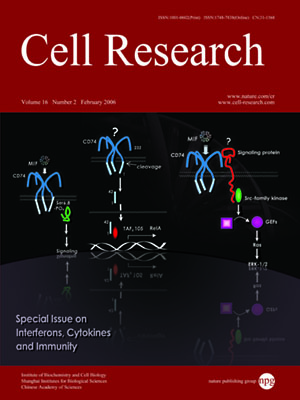
Volume 16, No 2, Feb 2006
ISSN: 1001-0602
EISSN: 1748-7838 2018
impact factor 17.848*
(Clarivate Analytics, 2019)
Volume 16 Issue 2, February 2006: 230-239
ORIGINAL ARTICLES
Redox regulation of mast cell histamine release in thioredoxin-1 (TRX) transgenic mice
Aoi Son1, Hajime Nakamura2, Norihiko Kondo1, Yoshiyuki Matsuo1, Wenrui Liu1, Shin-ichi Oka1, Yasuyuki Ishii3, Junji Yodoi1,2
1Department of Biological Responses, Institute for Virus Research, Kyoto University, 53 Shogoin Kawahara-cho, Sakyo-ku, Kyoto 606-8507, Japan; 2Department of Experimental Therapeutics, Translational Research Center, Kyoto University Hospital, 54 Shogoin Kawahara-cho, Sakyo-ku, Kyoto, 606-8507, Japan; 3Research Unit for Clinical Allergy, RIKEN Research Center for Allergy and Immunology, 1-7-22 Suehiro-cho, Tsurumi-ku, Yokohama, 230-0045, Japan
Correspondence: Junji Yodoi(yodoi@virus.kyoto-u.ac.jp)
Thioredoxin-1 (TRX) is a stress-inducible redox-regulatory protein with antioxidative and anti-inflammatory effects. Here we show that the release of histamine from mast cells elicited by cross-linking of high-affinity receptor for IgE (FcεRI) was significantly suppressed in TRX transgenic (TRX-tg) mice compared to wild type (WT) mice. Intracellular reactive oxygen species (ROS) of mast cells stimulated by IgE and antigen was also reduced in TRX-tg mice compared to WT mice. Whereas there was no difference in the production of cytokines (IL-6 and TNF-α) from mast cells in response to 2,4-dinitrophenylated bovine serum albumin (DNP-BSA) stimulation in TRX-tg and WT mice. Immunological status of TRX-tg mice inclined to T helper (Th) 2 dominant in primary immune response, although there was no difference in the population of dendritic cells (DCs) and regulatory T cells. We conclude that the histamine release from mast cells in TRX-tg mice is suppressed by inhibition of ROS generation. As ROS are involved in mast cell activation and facilitate mediator release, TRX may be a key signaling molecule regulating the early events in the IgE signaling in mast cells and the allergic inflammation.
Cell Research (2006) 16:230-239. doi:10.1038/sj.cr.7310031; published online 16 February 2006
FULL TEXT | PDF
Browse 2044


